
HMAS Success was a Durance-class multi-product replenishment oiler that previously served in the Royal Australian Navy (RAN). Built by Cockatoo Docks & Engineering Company in Sydney, Australia, during the 1980s, she is the only ship of the class to be constructed outside France, and the only one to not originally serve in the Marine Nationale. The ship was part of the Australian contribution to the 1991 Gulf War, and was deployed to East Timor in response to incidents in 1999 and 2006. The ship was fitted with a double hull during the first half of 2011, to meet International Maritime Organization standards.

HMAS Burnie (J198/B238/A112), named for the port city of Burnie, Tasmania, was one of 60 Bathurst-class corvettes constructed during World War II and one of 20 built for the Admiralty but manned by personnel of and commissioned into the Royal Australian Navy (RAN).

HMAS Melbourne (R21) was a Majestic-class light aircraft carrier operated by the Royal Australian Navy (RAN) from 1955 until 1982, and was the third and final conventional aircraft carrier to serve in the RAN. Melbourne was the only Commonwealth naval vessel to sink two friendly warships in peacetime collisions.

HMAS Sydney (R17/A214/P214/L134) was a Majestic-class light aircraft carrier operated by the Royal Australian Navy (RAN). She was built for the Royal Navy and was launched as HMS Terrible (93) in 1944, but was not completed before the end of World War II. The carrier was sold to Australia in 1947, completed, and commissioned into the RAN as Sydney in 1948.
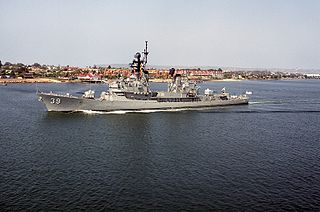
HMAS Hobart was a Perth-class guided missile destroyer of the Royal Australian Navy (RAN). Built in the United States of America to a slight variant of the United States Navy (USN) Charles F. Adams class, she was commissioned into the RAN in 1965. In March 1967, Hobart became the first RAN combat ship deployed to fight in the Vietnam War. This marked the start of consistent six-month deployments to the warzone, which continued until late 1971; Hobart was redeployed in 1969 and 1970. During the 1968 tour, the destroyer was attacked by a United States Air Force aircraft.
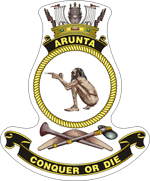
HMAS Arunta (I30/D5/D130) was a Tribal-class destroyer of the Royal Australian Navy (RAN). Named for the Arrernte Aboriginal peoples, the destroyer was laid down in 1939 and commissioned into the RAN in 1942.

HMAS Perth was the lead ship of the Perth-class guided missile destroyers operated by the Royal Australian Navy (RAN). Built in the United States to a modified version of the Charles F. Adams design, Perth entered service with the RAN in 1965.

HMAS Brisbane was one of three Perth-class guided missile destroyers to serve in the Royal Australian Navy (RAN). The United States-designed ship was laid down at Bay City, Michigan in 1965, launched in 1966 and commissioned into the RAN in 1967. She is named after the city of Brisbane, Queensland.
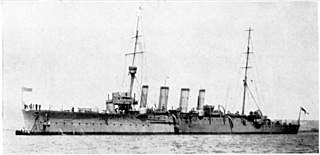
HMAS Melbourne was a Town class light cruiser operated by the Royal Australian Navy (RAN). The ship was laid down by Cammell Laird at Birkenhead in England in 1911, launched in 1912 and commissioned in 1913. At the start of World War I, Melbourne was involved in attempts to locate the German East Asia Squadron, and participated in the capture of German colonies in the Pacific, before being assigned to the North America and West Indies Stations. In 1916, the cruiser joined the Grand Fleet in the North Sea, where she remained for the remainder of the war. Melbourne spent late 1919 and early 1920 in reserve, then was flagship of the Royal Australian Navy from 1920 until 1928, except for a second period in reserve during 1924 and 1925. HMAS Melbourne paid off in the United Kingdom on 23 April 1928, and was scrapped in 1929.

HMAS Vampire was the third of three Australian-built Daring class destroyers serving in the Royal Australian Navy (RAN). One of the first all-welded ships built in Australia, she was constructed at Cockatoo Island Dockyard between 1952 and 1959, and was commissioned into the RAN a day after completion.

The Australian White Ensign is a naval ensign used by ships of the Royal Australian Navy (RAN) from 1967 onwards. From the formation of the RAN until 1967, Australian warships used the British White Ensign as their ensign. However, this led to situations where Australian vessels were mistaken for British ships, and when Australia became involved in the Vietnam War, the RAN was effectively fighting under the flag of another, uninvolved nation. Proposals were made in 1965 for a unique Australian ensign, which was approved in 1966, and entered use in 1967.
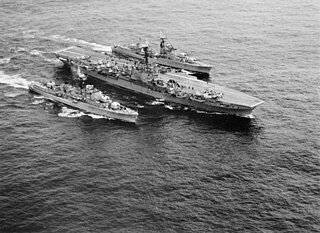
HMAS Vendetta was one of three Daring-class destroyers built for and operated by the Royal Australian Navy (RAN). The destroyer was built by Williamstown Naval Dockyard and entered service in 1958. During her early career, Vendetta was deployed to the Far East Strategic Reserve on multiple occasions. In 1965 and 1966, the destroyer undertook deterrence patrols during the Indonesia-Malaysia Confrontation. Along with several runs escorting the troop transport HMAS Sydney to South Vietnam, from late 1969 to early 1970 Vendetta was assigned to combat operations and became the only Australian-built warship to serve in a shore bombardment role during the Vietnam War.

HMAS Derwent, named for the Derwent River, was a River-class destroyer escort of the Royal Australian Navy (RAN). She was laid down by Williamstown Naval Dockyard in 1959, and commissioned into the RAN in 1964. During the ship's career, she was deployed to South East Asia on 23 occasions, including operations during the Indonesia-Malaysia Confrontation, and escort of the troopship HMAS Sydney to and from the Vietnam War. Multiple flag-showing cruises were also embarked upon, with port visits throughout Asia, the Indian Ocean, and the Pacific Ocean. Derwent was also briefly used to portray a fictional vessel for the British drama series Warship.

HMAS Jervis Bay was a roll-on/roll-off passenger and vehicle ferry operated by the Royal Australian Navy (RAN) between 1977 and 1994.

HMAS Tobruk was a Landing Ship Heavy (LSH) of the Royal Australian Navy (RAN), based on the design of the Round Table-class of the British Royal Fleet Auxiliary. Planning for the ship began in the 1970s to provide the Australian Army with a permanent sealift capability. She was laid down by Carrington Slipways in 1979, launched in 1980, and commissioned in 1981. She was a multi-purpose, roll-on/roll-off heavy lift ship capable of transporting soldiers, APCs, and tanks, and delivering them to shore via landing craft or directly by beaching.

The history of the Royal Australian Navy traces the development of the Royal Australian Navy (RAN) from the colonisation of Australia by the British in 1788. Until 1859, vessels of the Royal Navy made frequent trips to the new colonies. In 1859, the Australia Squadron was formed as a separate squadron and remained in Australia until 1913. Until Federation, five of the six Australian colonies operated their own colonial naval force, which formed on 1 March 1901 the Australian Navy's (AN) Commonwealth Naval Force which received Royal patronage in July 1911 and was from that time referred to as Royal Australian Navy (RAN). On 4 October 1913 the new replacement fleet for the foundation fleet of 1901 steamed through Sydney Heads for the first time.

HMAS Bungaree was an auxiliary minelayer of Royal Australian Navy (RAN), serving during World War II. The ship was built as a cargo vessel for the Adelaide Steamship Company by Caledon Shipbuilding & Engineering Company at Dundee, and launched in 1937. The ship operated in Australian waters and was requisitioned by the RAN in October 1940. Decommissioned on 7 August 1946 and returned to her owners on 5 November 1947, she was sold in 1957 and renamed Dampier. She was then sold in 1960 and renamed Eastern Mariner and while operating in South Vietnamese waters she struck a mine on the Saigon River and was sunk on 26 May 1966. She was salvaged by a Japanese company and subsequently scrapped in 1968.

HMAS Gladstone (J324/M324), named for the city of Gladstone, Queensland, was one of 60 Bathurst class corvettes constructed during World War II, and one of 36 that were initially manned and commissioned solely by the Royal Australian Navy (RAN). Built by Walkers Limited, the ship was commissioned in 1943.

HMAS Jeparit was an Australian National Line (ANL) bulk carrier which was operated by the Royal Australian Navy (RAN) between 1969 and 1972. She was launched in 1964 and transported supplies to Australian military forces in South Vietnam between 1966 and 1972 under both civil and military ownership. She returned to service with ANL in 1972, being sold in 1979 to a Greek shipping company and renamed Pleias. She continued in civilian service under several names before being broken up in 1993.
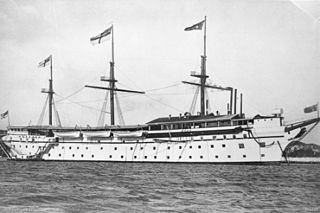
HMAS Tingira was a training ship operated by the Royal Australian Navy (RAN) between 1911 and 1927. Alexander Hall & Co. built the ship in Scotland in 1866 as the passenger clipper Sobraon; she was the largest composite-hull sailing vessel ever built. She sailed on an annual migration run between England and Australia until 1891, when she was sold to the colonial government of New South Wales for use as a reformatory ship. The vessel was then sold to the federal government in 1911, and entered RAN service. Tingira was paid off in 1927, but despite efforts to preserve the ship, was broken up in 1941.



















